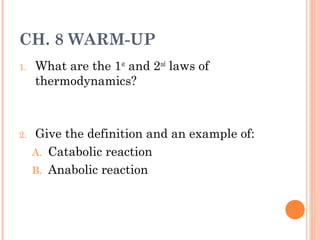
Chapter 8
- 1. CH. 8 WARM-UP 1. 2. What are the 1st and 2nd laws of thermodynamics? Give the definition and an example of: A. Catabolic reaction B. Anabolic reaction
- 2. CHAPTER 8 An Introduction to Metabolism
- 3. WHAT YOU NEED TO KNOW: Examples of endergonic and exergonic reactions. The key role of ATP in energy coupling. That enzymes work by lowering the energy of activation. The catalytic cycle of an enzyme that results in the production of a final product. The factors that influence enzyme activity.
- 4. Metabolism is the totality of an organism’s chemical reactions Manage the materials and energy resources of a cell
- 5. METABOLIC PATHWAYS pathways release energy by breaking down complex molecules into simpler compounds Eg. digestive enzymes break down food release energy Catabolic pathways consume energy to build complex molecules from simpler ones Eg. amino acids link to form muscle protein Anabolic
- 6. ENERGY = CAPACITY TO DO WORK energy (KE): energy associated with motion Heat (thermal energy) is KE associated with random movement of atoms or molecules Kinetic energy (PE): stored energy as a result of its position or structure Potential energy is PE available for release in a chemical reaction Chemical Energy can be converted from one form to another Eg. chemical mechanical electrical
- 8. THERMODYNAMICS IS THE STUDY OF ENERGY TRANSFORMATIONS THAT OCCUR IN NATURE A closed system, such as liquid in a thermos, is isolated from its surroundings In an open system, energy and matter can be transferred between the system and its surroundings Organisms are open systems
- 9. THE FIRST LAW OF THERMODYNAMICS The energy of the universe is constant Energy can be transferred and transformed Energy cannot be created or destroyed Also called the principle of Conservation of Energy
- 10. THE SECOND LAW OF THERMODYNAMICS Every energy transfer or transformation increases the entropy (disorder) of the universe During every energy transfer or transformation, some energy is unusable, often lost as heat
- 11. A cell does three main kinds of work: Mechanical Transport Chemical To do work, cells manage energy resources by energy coupling, the use of an: exergonic (energy releasing) process to drive an endergonic (energy absorbing) one
- 12. (adenosine triphosphate) is the cell’s main energy source in energy coupling Modified nucleotide ATP = adenine + ribose + 3 phosphates ATP
- 13. When the bonds between the phosphate groups are broken by hydrolysis energy is released This release of energy comes from the chemical change to a state of lower free energy, not in the energy phosphate bonds themselves
- 14. HOW ATP PERFORMS WORK Exergonic release of Pi is used to do the endergonic work of cell When ATP is hydrolyzed, it becomes ADP (adenosine diphosphate)
- 15. LE 8-11 Pi P Motor protein Protein moved Mechanical work: ATP phosphorylates motor proteins Membrane protein ADP + Pi ATP Pi P Solute transported Solute Transport work: ATP phosphorylates transport proteins P Glu + NH2 NH3 + Glu Pi Reactants: Glutamic acid Product (glutamine) and ammonia made Chemical work: ATP phosphorylates key reactants
- 16. Catalyst: Catalyst substance that can change the rate of a reaction without being altered in the process; not consumed Enzyme = biological catalyst; highly specific; named for reaction they catalyze Speeds up metabolic reactions by lowering the activation energy (energy needed to start reaction)
- 18. SUBSTRATE SPECIFICITY OF ENZYMES The reactant that an enzyme acts on is called the enzyme’s substrate The enzyme binds to its substrate, forming an enzyme-substrate complex The active site is the region on the enzyme where the substrate binds
- 22. INDUCED FIT: ENZYME FITS SNUGLY AROUND SUBSTRATE, “CLASPING HANDSHAKE”
- 23. An enzyme’s activity can be affected by: temperature pH Salinity Enzyme conc Substrate conc Activators Inhibitors
- 25. ENZYME/SUBSTRATE CONCENTRATION Enzyme Concentration As ↑ enzyme = ↑ reaction rate Reaction rate levels off when substrate becomes limiting factor. Not all enzyme molecules can find substrate. Substrate As Concentration ↑ substrate = ↑ reaction rate Reaction rate levels off when all enzyme have active site engaged. Enzyme is saturated. Max rate of reaction
- 26. COFACTORS Cofactors are nonprotein enzyme helpers such as minerals (eg. Zn, Fe, Cu) Coenzymes are organic cofactors (eg. vitamins) Enzyme Inhibitors Competitive inhibitors bind to the active site of an enzyme, competing with the substrate Noncompetitive inhibitors bind to another part of an enzyme, causing the enzyme to change shape and making the active site nonfunctional
- 28. REGULATION OF ENZYME ACTIVITY To regulate metabolic pathways, the cell switches on/off the genes that encode specific enzymes Allosteric regulation: protein’s function at one site is affected by binding of a regulatory molecule to a separate site (allosteric site) Activator – stabilizes active site Inhibitor – stabilizes inactive form Cooperativity – one substrate triggers shape change in other active sites increase catalytic activity
- 31. FEEDBACK INHIBITION End product of an metabolic pathway shuts down pathway by binding to the allosteric site of an enzyme Prevent wasting chemical resources, increase efficiency of cell